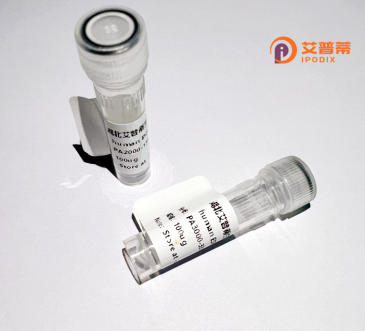
| 纯度 | >90%SDS-PAGE. |
| 种属 | Human |
| 靶点 | BRF2 |
| Uniprot No | P47974 |
| 内毒素 | < 0.01EU/μg |
| 表达宿主 | E.coli |
| 表达区间 | 1-494aa |
| 氨基酸序列 | MPGRGRCPDCGSTELVEDSHYSQSQLVCSDCGCVVTEGVLTTTFSDEGNLREVTYSRSTGENEQVSRSQQRGLRRVRDLCRVLQLPPTFEDTAVAYYQQAYRHSGIRAARLQKKEVLVGCCVLITCRQHNWPLTMGAICTLLYADLDVFSSTYMQIVKLLGLDVPSLCLAELVKTYCSSFKLFQASPSVPAKYVEDKEKMLSRTMQLVELANETWLVTGRHPLPVITAATFLAWQSLQPADRLSCSLARFCKLANVDLPYPASSRLQELLAVLLRMAEQLAWLRVLRLDKRSVVKHIGDLLQHRQSLVRSAFRDGTAEVETREKEPPGWGQGQGEGEVGNNSLGLPQGKRPASPALLLPPCMLKSPKRICPVPPVSTVTGDENISDSEIEQYLRTPQEVRDFQRAQAARQAATSVPNPP |
| 分子量 | 71.83 kDa |
| 蛋白标签 | GST-tag at N-terminal |
| 缓冲液 | 冻干粉 |
| 稳定性 & 储存条件 | Lyophilized protein should be stored at ≤ -20°C, stable for one year after receipt. Reconstituted protein solution can be stored at 2-8°C for 2-7 days. Aliquots of reconstituted samples are stable at ≤ -20°C for 3 months. |
| 复溶 | Always centrifuge tubes before opening.Do not mix by vortex or pipetting. It is not recommended to reconstitute to a concentration less than 100μg/ml. Dissolve the lyophilized protein in distilled water. Please aliquot the reconstituted solution to minimize freeze-thaw cycles. |
以下是关于重组人BRF2蛋白的3篇文献概览(仅供参考,建议通过专业数据库验证内容):
1. **文献名称**: *BRF2 overexpression promotes malignant transcription programs in human cancers*
**作者**: Gou LT, et al.
**摘要**: 研究通过泛癌分析发现BRF2在多种肿瘤中异常高表达,揭示其通过调控RNA聚合酶III依赖性转录驱动肿瘤细胞增殖,并可能成为癌症治疗的靶点。
2. **文献名称**: *Structural insights into RNA polymerase III recruitment by BRF2*
**作者**: Yang L, et al.
**摘要**: 采用冷冻电镜解析了BRF2蛋白与RNA聚合酶III复合物的三维结构,阐明其通过特定结构域招募RNA聚合酶III并激活小RNA转录的分子机制。
3. **文献名称**: *BRF2 cooperates with p53 to regulate DNA damage response*
**作者**: Chen X, et al.
**摘要**: 发现BRF2通过与p53蛋白相互作用参与DNA损伤修复通路,重组人BRF2在体外实验中被证明可增强p53转录活性,提示其在细胞应激反应中的新功能。
注:建议通过PubMed/Google Scholar输入关键词“BRF2”、“recombinant BRF2”获取准确文献信息。部分经典文献可能涉及BRF2在tRNA转录中的基础功能研究。
Recombinant human BRF2 (B-related factor 2) protein is a key transcription factor involved in RNA polymerase III (Pol III)-mediated gene expression. As a component of the TFIIIB complex, BRF2 specifically recruits RNA Pol III to synthesize small non-coding RNAs, including 5S rRNA, tRNAs, and other regulatory RNAs essential for cellular functions like translation and RNA processing. Structurally distinct from BRF1. BRF2 lacks conserved N-terminal domains but shares a C-terminal region critical for promoter binding and Pol III interaction. Its activity is tightly regulated, with expression patterns linked to cell proliferation and tumorigenesis. Studies suggest BRF2 overexpression is associated with cancers like lung squamous cell carcinoma and breast cancer, where it drives oncogenic transformation by enhancing Pol III transcription.
Recombinant BRF2 is typically produced using bacterial or mammalian expression systems, enabling biochemical studies of TFIIIB complex assembly, promoter recognition, and transcription initiation mechanisms. Its applications span structural analysis, drug screening, and functional assays to explore Pol III dysregulation in diseases. Challenges in recombinant production include maintaining solubility and post-translational modifications, which influence its DNA-binding capacity. Ongoing research focuses on BRF2’s therapeutic targeting potential, given its role in cancer progression and stem cell maintenance, offering insights into novel treatment strategies for Pol III-dependent pathologies.
×